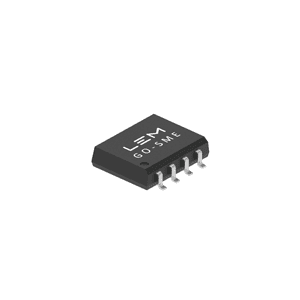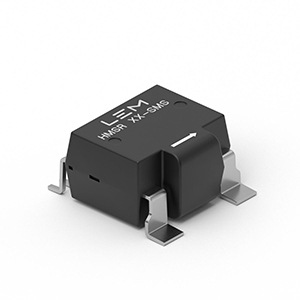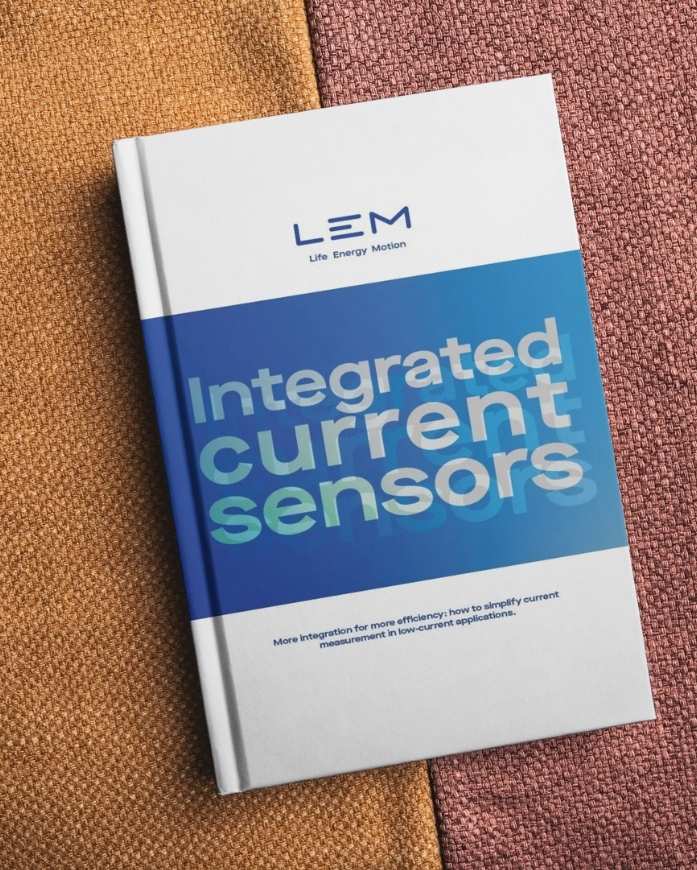INTEGRATED CURRENT SENSORS
Current sensors have to be smaller, smarter, cheaper. LEM’s R&D is actively developing a range of Current Sensor IC to reduce the footprint of the current sensing function and simplify the integration of current measurement in a wide range of applications in automotive, industrial, or residential.
At low currents, shunts remain a viable solution, but they have isolation challenges and cannot provide the current sensing function alone. They require amplifiers and/or analogue-digital conversion (ADC) for signal treatment of the measured voltage drop.
Thanks to technical progress in semiconductor manufacturing and packaging, it is now possible to integrate all the stages of a current sensor in 1 single package. Current flows through the device, the induced magnetic field is sensed by two Hall-effect plates, the operation is contactless and provides inherent galvanic isolation, the voltage signal is treated inside an application-specific integrated circuit (ASIC) and this very ASIC also allows to add other ad hoc features.
As a leader in electrical measurement for 50 years, LEM is constantly developing new technologies to fit customers evolving needs. The company is now building a complete Current Sensor ICs range to serve evolving needs as well as new applications.
GO series

- Standard package and small footprint
- Cost effective
- A perfect compromise for small drives, robots, solar inverters, e-bikes etc.
Main features
- 1% accuracy at 25°C
- Low drifts (offset: 75uV/°C, Gain: 200ppm)
- 17mA power consumption
- Fixed and ratiometric output
HMSR series

- SOIC 16 compatible footprint
- Great accuracy: Typical accuracy is 0.5% over temperature and the measurement range
- Small hysteresis of <0.5%
- Strong immunity
Main features
- Current range 6-30 Arms continuous at 125°C (75 A peak)
- Isolation: 4,950 Vrms
- Global accuracy -25°C: 0.78 %
- Global accuracy -Over T° C: 1.4 %
FHS Series

- Standard package and small footprint
- Cost effective
- Standard SOIC 8 surface mount PCB
Main features
- Hall effect current sensor with Integrated Magnetic Concentrator (IMC)
- Magnetic field measurement range ±3.3 mT
- Low power consumption
- High bandwidth: 160 kHz
More about LEM’s Current Sensor IC
What is an Integrated Current Sensors?
Current Sensors ICs are Hall-effect based sensors that integrate the current conductor, the sensing elements, the signal treatment die, some dedicated features such as fault detections, and the isolation, all in one single package to reduce the footprint of the current sensing function.
Why use a Current Sensor IC?
For low current, shunts remain an alternative, but they have isolation issues and require additional electronics parts to fully complete the current sensing function. Current Sensor ICs are highly integrated products that work seamlessly in every application. At LEM they are the result of leveraging 50 years of fundamental electrical knowledge, customers applications understanding and product innovation. Isolated current sensors are the most optimized pieces of hardware to sense the current in every environment.
What is the technology used in LEM’s Current Sensor IC?
Current Sensor ICs can use Hall-effect technology for current sensing.
Hall-effect sensing is one way to do contactless measurement of the current-induced magnetic field. A Hall cell is a sensing element that converts a change in the magnetic field into a change of its resistance. When a constant current goes through the hall cell, it will give a voltage output change proportional to the magnetic field.
Contrary to traditional Hall-effect current sensors, integrated current sensors are not using a ferrite core around the current conductor and the sensing elements to concentrate the magnetic field. They are using differential measurement.
Thanks to differential measurement, it is possible to get rid of the ferrite core while keeping a good response to external fields perturbations. Differential measurement uses 2 sensing elements (the Hall cells). They both receive the magnetic field to be measured, one with a positive factor, and the other with a negative factor. They also receive any external fields with the same incidence. When making the difference between the fields seen by the 2 cells, the unwanted fields cancel each other.
5 advantages of LEM Isolated Current Sensors as current sensors
Current sensors IC take advantage of differential measurement by not using a ferrite core. Getting rid of the magnetic core offers several benefits for embedded applications:
- Reduce cost
- Increases power density on sensing side – up to 75A in 800V applications for LEM Isolated Current Sensors products.
- Current measure is not subject to offset from magnetic hysteresis.
- Operating temperature not limited to the Curie temperature above which a ferrite can experience demagnetization (105°C), but rather by the maximum junction temperature of the device.
- Frequency and bandwidth are not limited by the inherent saturation of the magnetic element of the core.
What are the applications where Sensors IC can make the difference?
Current Sensor ICs are suitable for a wide range of applications where accurate control, efficiency and protection is needed. They allow designers to realize the current sensing function with a plug-and-play approach, with virtually all their challenges solved using only one part.
In DC/AC inverters and motors drives for example, LEM GO and HMSR can increase compactness and simplify design :
- Low power loss integrated sensors can be put closer to heat sources such as microcontroller and transistors
- Integrated isolation simplifies PCB layout
- Built-in OCD makes sure the microcontroller can put the system in safe state with minimal delay.
Standards and certificates
| GO Series | HMSR Series |
|---|---|
| IEC 61800-5-1: 2007 | IEC 61800-5-1: 2007 |
| IEC 62109-1: 2010 | IEC 62109-1: 2010 |
| IEC 62368-1:2018 (supersedes IEC 60950-1: 2005) | IEC 60950-1: 2005 |
| UL 1577: 2014 | UL 1577: 2014 (pending) |
| UL 62368: 2019. |
Download our Current Sensor IC Whitepaper

Explore the world of integrated current sensors with our comprehensive whitepaper.
As electronics become more powerful and compact, isolated current sensors offer a solution for accurate, reliable current sensing in space-constrained applications.
This guide provides an in-depth look into the efficient and safe applications of these sensors, reflecting LEM's commitment to innovation and sustainability.